NBA mock draft 1.0: NCAA tourney stars sprinkled throughout
The NBA draft is still months away, but after the NCAA tournament is an ideal time to start thinking about it. This is an intriguing class because of blue-chip freshman talent (Deandre Ayton, Marvin Bagley III and Michael Porter Jr.), top-tier European players (Luka Doncic and Dzanan Musa) and a range of marquee upperclassmen (Mikal Bridges and Grayson Allen). And while individual workouts and the Chicago predraft combine will alter the landscape, here is Yahoo Sports’ first mock for the June 21 draft.

1. Phoenix Suns: C Deandre Ayton, Fr., Arizona
“Ayton is a beast,” one veteran executive told Yahoo Sports. The 6-foot-11, 260-pound Ayton is the best player in this draft, and also has the highest upside, which is something I’ve previously written about. He has a near 7-foot-6 wingspan and 9-3 standing reach. Phoenix needs a lot of help, most notably a legitimate offensive big man to play off Devin Booker. Ayton is a physical specimen who can really score. He stretches the floor as a shooter and you can put him in any ball-screen situation as a result. After a brilliant freshman campaign in Tucson, the Bahamas native quelled any concern of not having a motor. Booker is an emerging superstar for the Suns, Josh Jackson has all of the tools to be a big-time two-way wing and Ayton can be the big man of the future.
2. Memphis Grizzlies: G/F Luka Doncic, Slovenia
“Doncic is a killer,” said a former European lottery pick who has watched Doncic play for years. Doncic, 19, has an immense skill set, with the ability to handle the ball, shoot and create off the bounce. At 6-8, 225 pounds, Doncic should be able to immediately contribute in the NBA. He has been one of the premier players in Spain’s prestigious ACB League, the second-best league in the world. Doncic can shoot the NBA three and has a sound pick-and-roll game, as well, but he also has a world-class feel on the court.
3. Atlanta Hawks: F Marvin Bagley III, Fr., Duke
There was one game all season in which Bagley didn’t score at least 12 points and that’s because he was hurt. Bagley’s ability to score on the block is rare, and he has an elite first step — which I have written about — and a smooth shooting stroke from the college 3-point line. An excellent athlete who runs the floor like a gazelle, Bagley is an ideal three or four man who should be able to post double-double numbers. The Hawks need an infusion of young talent and Bagley — whom three veteran executives have told Yahoo Sports is essentially a carbon copy of Chris Bosh — is the right place to start.
4. Orlando Magic: F Michael Porter Jr., FR., Missouri
An injury-riddled freshman campaign kept Porter sidelined for all but three games, but come draft time, it won’t matter. Porter is that talented and versatile. As one NBA GM told Yahoo Sports: “He was unanimously the No. 1 player in the country out of high school. … He’s really good.” With his fluidity, ball-handling and natural scoring ability, Porter reminds me of the Celtics’ Jayson Tatum.
5. Dallas Mavericks: F Jaren Jackson Jr., Fr., Michigan State
The youth movement continues for the Mavs. Jackson, a 6-10 jumping jack, is an ideal complement to Dennis Smith Jr. because of his dexterity, quickness and ability to pick-and-pop. As a freshman, he connected on 40 percent of his threes, and his defensive flexibility is a huge plus for a Dallas team that lacks an identity.
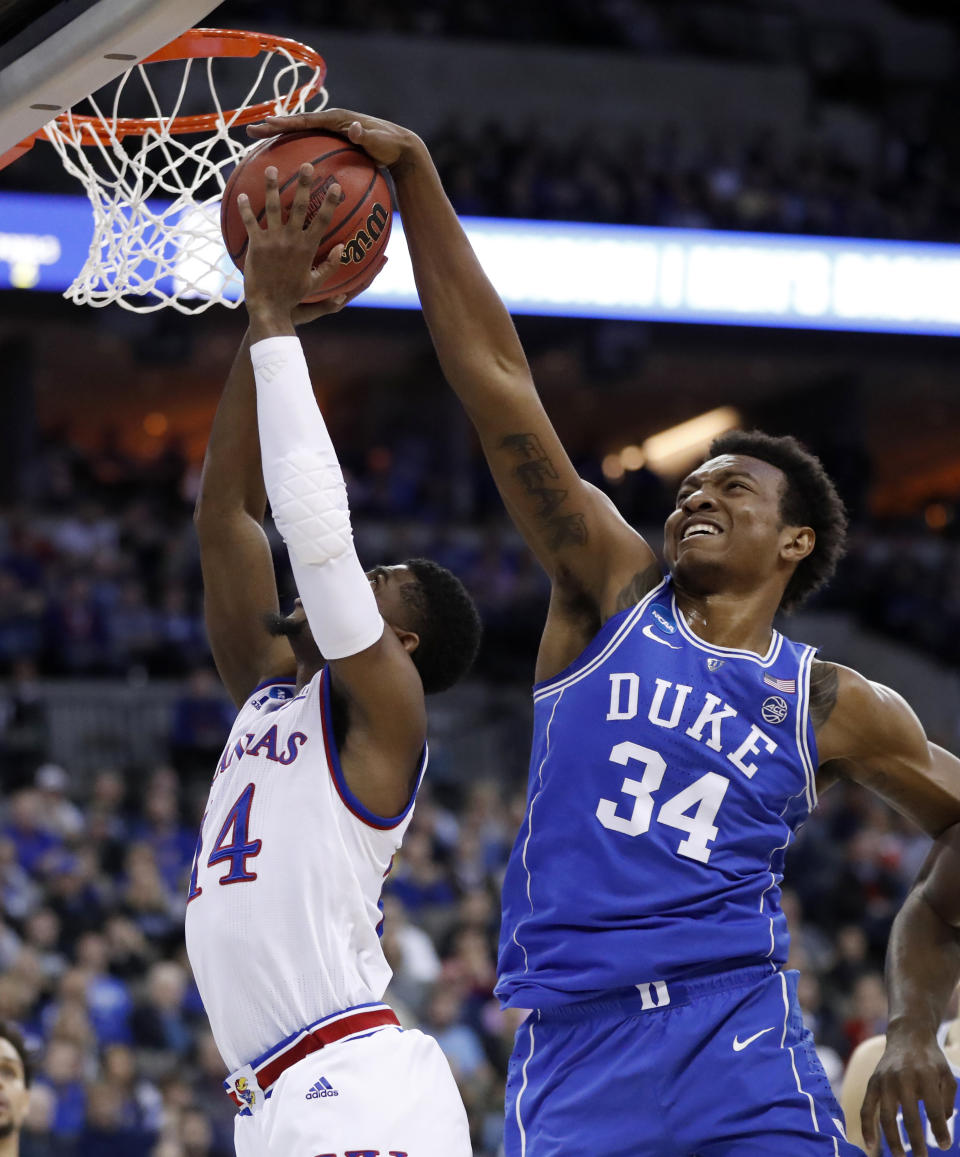
6. Sacramento Kings: C Wendell Carter, Fr., Duke
Carter was often overlooked this year because of teammate Marvin Bagley. Well, no more. Two NBA executives told Yahoo Sports that he reminds them of Boston Celtics standout center and five-time All-Star, Al Horford. Carter is still growing into his massive 6-11, 260-pound frame and has soft hands and a soft touch around the basket. He also rebounds at an elite clip, hauling in nearly 14 boards per 40 minutes. Carter is a classic, throwback center with a hint of new-school game given his ability to shoot from 16 feet.
7. Cleveland Cavaliers: PG Collin Sexton, Fr., Alabama
Sexton fills a need and is precisely the type of point guard the Cavs need: a defensive bulldog who is constantly getting downhill off the bounce to create for either himself or teammates. A high-level athlete who excels in the open floor, Sexton has shown the capacity to play the pick-and-roll game at a high level as well.
8. Chicago Bulls: PG Trae Young, Fr., Oklahoma
What stands out about Young is not merely his ability to shoot the basketball — which we know is very special — but also his dynamic passing and capacity to see the entire floor, which led to 8.7 assists per game. Get him in the open floor of an NBA game and he will excel in a way the restrictive nature of college never afforded him. Question marks about his defense — which is atrocious — will persist, as well as concerns about his slight 6-2 (closer to 6-1), 180-pound frame. But Young’s skill set and basketball IQ are special — and he will allow the bigger Kris Dunn to slide off the ball.
9. New York Knicks: C Mo Bamba, Fr., Texas
Bamba is intriguing for a number of reasons. He stands a legitimate 7-feet and possesses an Inspector Gadget-esque 7-9 wingspan, with a 9-5 standing reach. Length matters in the NBA more than ever, and as Bamba continues to shore up his rail-thin frame — he will spend the summer working with famed trainer Drew Hanlen — he will become a more NBA-ready player. His tendency to disappear in games and overall inconsistency are why he will fall this far. A pairing with Kristaps Porzingis in the frontcourt, though, will give the Knicks one of the longest and potentially most skilled big men duos in basketball. Bamba is also a terrific kid who will be well liked by older teammates, despite his blue-chip pedigree.
10. Philadelphia 76ers: SG/SF Mikal Bridges, Jr., Villanova
The 6-7 Bridges is everything the 76ers covet: a versatile “3-and-D” wing with the potential not merely to be a third or fourth option, but perhaps a go-to guy at some point in his career. One GM has raved to me about him since the beginning of the season. Tough and hard-nosed, Bridges — with his 7-2 wingspan — is an effective cutter who can also play on the ball and extend a defense with his 43.5 percent 3-point shooting. The third-team All-American morphed from a reserve on Jay Wright’s national title team two years ago into one of the most coveted players in the whole draft.
11. Charlotte Hornets: F Kevin Knox, Fr., Kentucky
Knox parlayed a strong second half of his freshman year to become a potential lottery pick. A smooth-shooting 6-9, 215-pound wing who can play on and off the ball, Knox could give Kemba Walker and the Hornets a much needed scoring boost. The former McDonald’s All American made just 34 percent of his threes, but that number will only improve given his sound mechanics and ability to shoot on the move. In terms of sheer metrics, Knox is a prototypical NBA wing with his 7-1/4 wingspan and 36 1/2-inch vertical. His upside is that much higher considering he won’t turn 19 until August.
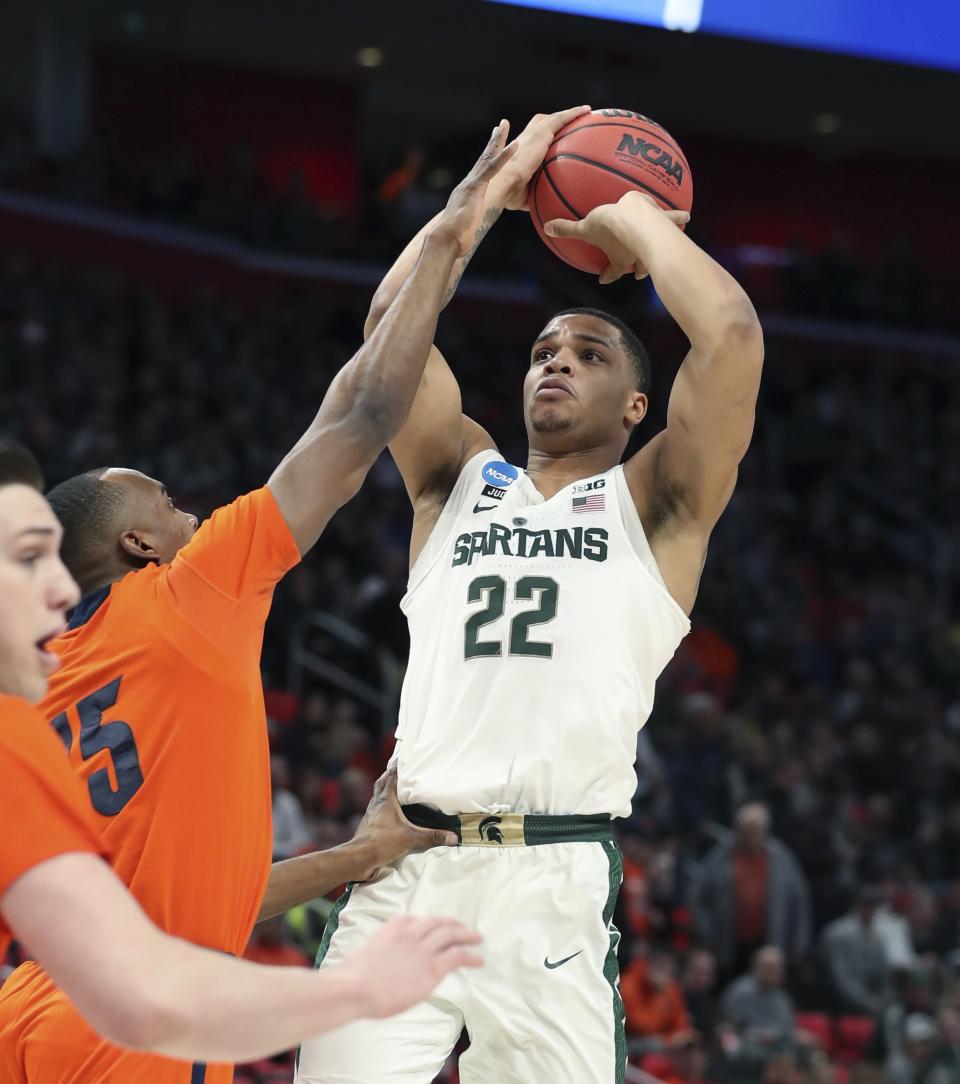
12. Los Angeles Clippers: F Miles Bridges, Soph., Michigan State
After a hype-filled freshman season, Bridges — almost quietly — had a super-productive sophomore season, posting 17.1 points and seven rebounds per game while hitting 36 percent of his threes. The 6-6 wing is a sensational athlete who will need to show he can guard both the paint and the perimeter — both of which the Clippers need.
13. Denver Nuggets: PF/C Robert Williams, Soph., Texas A&M
Denver needs an active big man who can control the paint and allow the versatile Nikola Jokic to play more pick-and-pop and not always bang in the paint. Williams, at 6-10, 241 pounds, comes off a terrific sophomore season in which he averaged 10.4 points, 9.2 rebounds and 2.6 blocks per game. He is just scratching the surface of his enormous potential. He has a near 7-6 wingspan, excellent hands and — maybe most importantly for the Nuggets — the ability to run the floor and switch ball screens. Remember, Denver ranks just 23rd in points allowed this season. Williams will bolster that number from Day 1.
14. Los Angeles Clippers: G Khyri Thomas, Jr., Creighton
Thomas, who will turn 22 by the draft, has a lot of Gary Harris to his game. At 6-3, he isn’t especially big, but because of his sensational length (6-10 wingspan) and high-level athleticism, Thomas plays bigger. More importantly, he also plays with great balance and pace, able to come off screens and shoot, but he can also get into the teeth of the defense and make a play. Better yet, he plays with a control and pace that you rarely find in young combo guys. Thomas is a versatile offensive weapon who can guard both NBA backcourt spots. He is precisely what the Clippers need and represents great value at the tail end of the lottery.
15. Phoenix Suns: SG Zhaire Smith, Fr., Texas Tech
Smith comes off a stellar freshman year in which he showcased a pro-style game with versatility at both ends of the floor. At 6-5, 195 pounds, he is a prototypical NBA shooting guard. Still a bit streaky, he tends to disappear at times and he’s not that creative with the ball just yet. But he remains a big-time talent and sensational athlete who shoots 45 percent from 3-point range. “Smith is a future pro,” a Big 12 coach told Yahoo Sports. “He has a really high IQ and feel for the game. He’s an NBA athlete. Just look at how much his skills have improved.”
16. Phoenix Suns: SG Gary Trent Jr., Fr., Duke
Trent came on late for Duke, displaying his smooth midrange game — think Ron Mercer — and eagerness to make the big shot. Not especially shifty, he instead relies on a change-of-pace approach that often frees him to pull up, or use his burly 6-6, 235-pound frame to absorb contact. Trent is ready to contribute right away and his ability to play off the ball will mesh well with standout performer Devin Booker.
17. Washington Wizards: G Troy Brown, Fr., Oregon
To be sure, Brown is a project. He has the all of the measurables (6-6, 6-11 wingspan and an 8-4 standing reach), and he is very explosive in the open floor. But he made just 29 percent of his triples as a freshman and only attempted three free throws per game. Brown often doesn’t play anywhere near his talent level, drifting on the perimeter and making soft cuts. In three Pac-12 tournament games, Brown made just 1-of-8 3-point attempts and hit 8-of-31 shots from the floor.
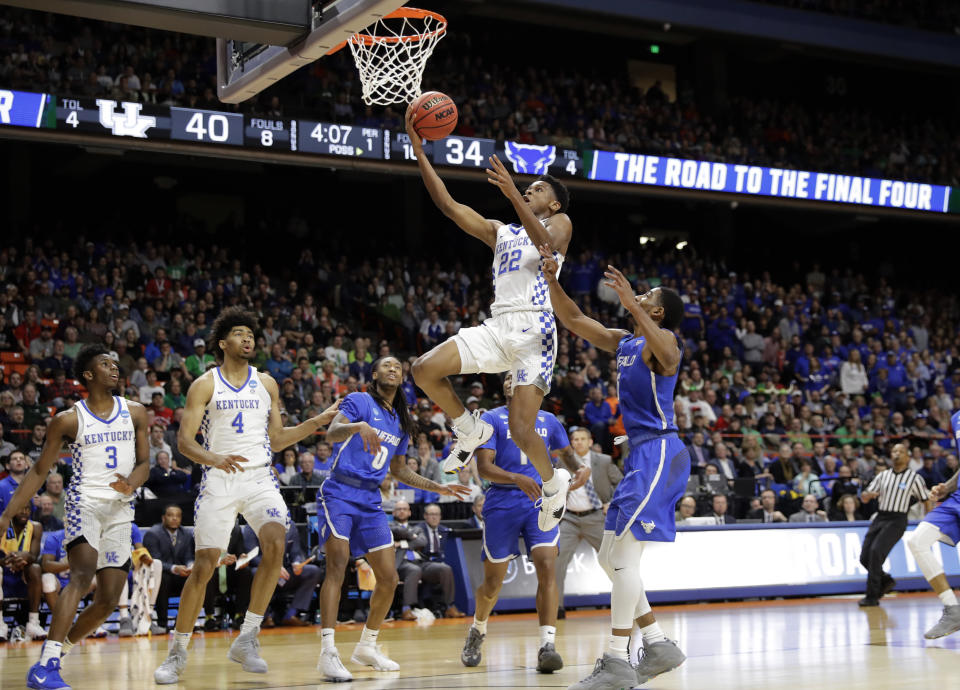
18. Atlanta Hawks: PG Shai Gilgeous-Alexander, Fr., Kentucky
At 6-6, Gilgeous-Alexander possesses fantastic size for a lead guard, which helps offset his lack of a killer first step. As he becomes a more effective shooter out of the pick-and-roll, his length and intelligence will lend itself well to the NBA game. Already though, he shows the aptitude necessary to become a high-level defender.
19. Utah Jazz: SF Dzanan Musa, Bosnia and Herzegovina
Get to know this name. Musa is a positionless 6-9 perimeter weapon who doesn’t turn 19 until May. He is a highly competitive and skilled offensive player who can play both on and off the ball. With his size and feel, Musa sees over the top of the defense and shows a natural capacity to run the pick-and-roll. He passes the ball and plays with a fluidity you often don’t see from a teenager. More than anything, Musa’s rare scoring ability will instantly translate to the NBA game.
20. Chicago Bulls: SG Lonnie Walker IV, Fr., Miami
Walker is purely an upside pick, and already having nabbed Trae Young, the Bulls could very well go big here. At 6-4, 192 pounds with a solid shooting stroke and length though, Walker has all of the physical tools to become a starting two guard. His freshman campaign was wildly inconsistent, making fewer than 35 percent of his threes. As a pro, Walker will struggle defending, at least early on, because his body still needs time to develop as he learns the game. But his robust length and quickness should help accelerate the process.
21. San Antonio Spurs: PG Jalen Brunson, Jr., Villanova
Brunson, a consensus first-team All-American, was college basketball’s best player this season. His advanced post game and sensational shooting ability (52-41-80 shooting splits) make him good, but what makes him great is his rare feel for the game and ability to play at the precise pace he wants. With the talented and versatile Dejounte Murray still in the infancy stages of his development, Brunson — a potential second coach on the floor — is the ideal replacement for Tony Parker, especially given his effectiveness operating the pick-and-roll. Brunson and Murray have much different games, so the Spurs avoid duplicity as well.
22. Indiana Pacers: PG Trevon Duval, Fr., Duke
Duval played well in the tournament, showcasing his quick first step and overall bounce. An inability to spread the floor will surely plague him moving forward. As one GM told Yahoo Sports, being a small guard and not being a lights-out shooter make it nearly impossible to succeed in the NBA. Duval’s shiftiness and pick-and-roll game (he averaged almost six assists) will have to propel him as he becomes a better shooter. The Delaware native was more efficient playing off the ball, but concerns about his shaky jumper are legitimate: He connected on just 31 triples all season for the Blue Devils.
23. Philadelphia 76ers: G Aaron Holiday, Jr., UCLA
Holiday is a better natural scorer than older brother Jrue, something a GM touched on, telling Yahoo Sports: “I like Aaron. He’s a good player who can score.” He plays with the same fluidity and sudden change-of-pace ability, however, and he can really shoot it (43 percent from deep). Because of his lack of size at 6-foot-1, 185 pounds — and limited length — Holiday’s NBA role is likely to be as a microwave off the bench. Holiday, who averaged 20.3 points for UCLA, represents nice value at this point in the draft.
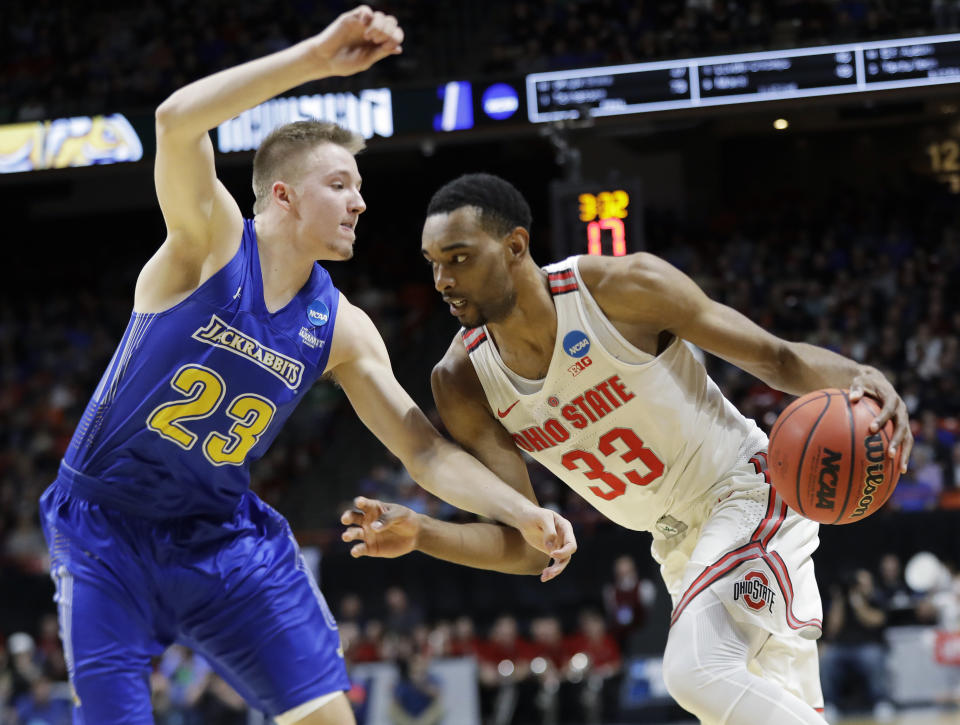
24. Minnesota Timberwolves: F Keita Bates-Diop, RS Jr., Ohio State
Bates-Diop, 22, has a pro-style game in that he can spread the floor (35.9 percent on threes), defend multiple positions, put the ball on the deck and really rebound (8.7 per game). He can be a plug-and-play contributor from Day 1, and Bates-Diop — the Big Ten Player of the Year — should be effective on both sides of the floor. And, because he is effective off the floor, he will blend nicely alongside Andrew Wiggins and Jimmy Butler.
25. Los Angeles Lakers: PF/C Jontay Porter, Fr., Missouri
Porter had a strong freshman season, posting healthy averages of 9.9 points and 6.8 rebounds in 24.5 minutes. He is a brute in the paint with decent touch and high motor. The Lakers won’t ask him to score, and that’s just fine by Porter. An active, physical big man with an improved pick-and-pop game, he should enjoy a long career.
26. Portland Trail Blazers: C Mitchell Robinson
Robinson, 20, never played a single game at Western Kentucky and was granted his release, so tape is limited on the former five-star recruit. Here’s what we do know, however: He measures a legit 7-feet tall with a 7-4 wingspan and incredible 9-3 standing reach. He has good feet and the dexterity to cover up mistakes on defense, not just those made by himself, but by teammates as well. Plus, he can shoot. Simply put, the Blazers need an athletic big to pair with Jusuf Nurkic, and with Robinson, they get a lottery-type talent late in the first round.
27. Bostin Celtics: SG Grayson Allen, Sr., Duke
Allen’s peculiar career culminated in a good but disappointing tenure to many observers. His shooting percentages plummeted from 42 percent from three as a sophomore to 37 percent as a senior. His lack of an elite first step hurts his draft stock, too, but Allen remains a capable scorer who will benefit from the open nature of the NBA game, particularly with his coast-to-coast capabilities in transition.
28. Golden State Warriors: G Anfernee Simons, IMG Academy
Simons, who already graduated from his Orlando, Florida, high school and spent a post-grad year at IMG Academy, would benefit from a year in college to develop his 18-year-old body. His raw tools, though, are why the Warriors should nab him in the first round. A true combo man with multiple ways to beat you, Simons stands about 6-4 with a 6-7 wingspan. He possesses a refined shooting stroke, capable of pulling up from virtually anywhere. Remember, Shaun Livingston is 32 years old and Patrick McCaw becomes a free agent this summer. Simons can become an ideal third guard for coach Steve Kerr, especially given his flexibility as an offensive player, though there will certainly be a steep learning curve.
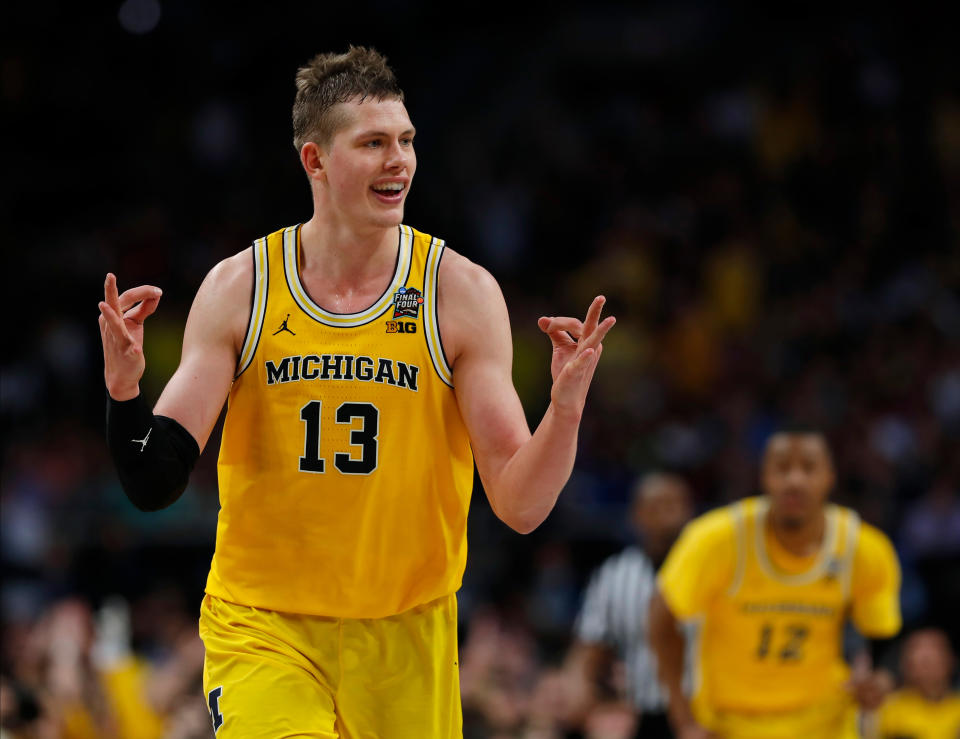
29. Brooklyn Nets: F Moritz Wagner, Jr., Michigan
Wagner’s excellent NCAA tournament run might eventually elevate him into the top 20, but for now at least, he comes in at No. 29. With respect to Quincy Acy, Brooklyn needs a skilled four man to play off of D’Angelo Russell and Spencer Dinwiddie. Wagner, who turns 21 this month, can shoot (39 percent on threes), attack off the bounce and loves to rebound (10.3 boards per 40 minutes). The German won’t back down either. He plays with a nastiness and grit that head coach Kenny Atkinson will admire and teammates will appreciate.
30. Atlanta Hawks: F Killian Tillie, Soph., Gonzaga
Tillie’s growth in just two years at Gonzaga suggests he is just scratching the surface of his enormous potential. The Frenchman is a bouncy three-four man who at 6-10 can impact the game in a variety of ways. Atlanta needs talent right now, and Tillie — who can run and jump — is an intriguing prospect with lottery ability. He averaged 20 points and nine rebounds per 40 minutes for the Zags after a limited role as a freshman.
CORRECTION: A previous edition of this article incorrectly stated that Mo Bamba is 6-11, with a 7-7 wingspan and 9-4 standing reach. It has been corrected to reflected that Bamba is 7-feet. with a 7-9 wingspan and 9-5 standing reach.
– – – – – – –
Follow Jordan Schultz on Twitter and Instagram @Schultz_Report
Jordan Schultz is an NFL, NBA and NCAAB insider/analyst for Yahoo Sports.

